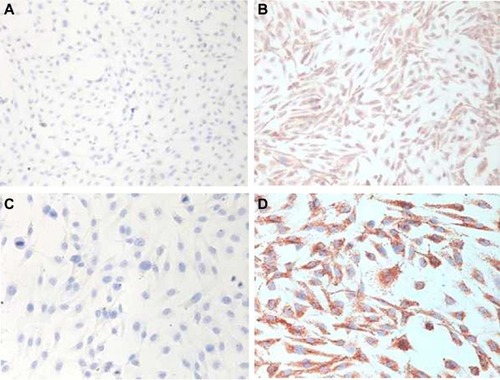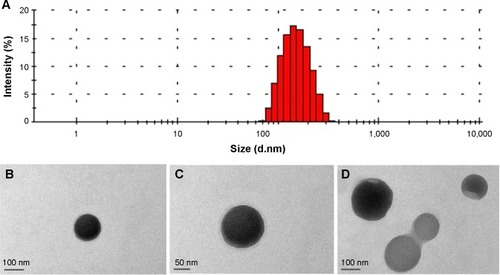 ?Mathematical formulae have been encoded as MathML and are displayed in this HTML version using MathJax in order to improve their display. Uncheck the box to turn MathJax off. This feature requires Javascript. Click on a formula to zoom.
?Mathematical formulae have been encoded as MathML and are displayed in this HTML version using MathJax in order to improve their display. Uncheck the box to turn MathJax off. This feature requires Javascript. Click on a formula to zoom.Abstract
Background
Cell therapy is a promising strategy for tissue regeneration. Key to this strategy is mobilization and recruitment of exogenous or autologous stem/progenitor cells by cytokines. However, there is no effective cytokine delivery system available for clinic application, in particular for myocardial regeneration. The aim of this study was to develop a novel cytokine delivery system that is stable in solution at physiological pH.
Methods
Four groups of self-assembled chitosan oligosaccharide/heparin (CSO/H) nanoparticles were prepared with various volume ratios of chitosan oligosaccharide to heparin (5:2, 5:4, 4:15, 1:5) and characterized by laser diffraction, particle size analysis, and transmission electron microscopy. The encapsulation efficiency and loading content of two cytokines, ie, stromal cell-derived factor (SDF)-1α and vascular endothelial growth factor (VEGF) were quantified using an enzyme-linked immunosorbent assay. The biological activity of the loaded SDF-1α and VEGF was evaluated using the transwell migration assay and MTT assay. The dispersion profiles for the cytokine-loaded nanoparticles were quantified using fluorescence molecular tomography.
Results
CSO/H nanoparticles were prepared successfully in solution with physiological pH. The particle sizes in the four treatment groups were in the range of 96.2–210.5 nm and the zeta potential ranged from −29.4 mV to 24.2 mV. The loading efficiency in the CSO/H nanoparticle groups with the first three ratios was more than 90%. SDF-1α loaded into CSO/H nanoparticles retained its migration activity and VEGF loaded into CSO/H nanoparticles continued to show proliferation activity. The in vivo dispersion test showed that the CSO/H nanoparticles enabled to VEGF to accumulate locally for a longer period of time.
Conclusion
CSO/H nanoparticles have a high cytokine loading capacity and allow cytokines to maintain their bioactivity for longer, are stable in an environment with physiological pH, and may be a promising cytokine delivery system for tissue regeneration.
Introduction
Tissue damage occurs in many diseases, including diabetes, acute graft-versus-host disease, and cardiovascular disease.Citation1 Of these diseases, myocardial infarction, one of the leading causes of mortality, is the most common and difficult to treat in the clinic, because cardiomyocytes are not able to regenerate.Citation2 Tissue regeneration through stem/progenitor cells has been studied extensively in a wide range of tissue repair applications, especially for regeneration of cardiomyocytes, owing to the unique pluripotency and regenerative properties of these cells.Citation3,Citation4 However, tissue regeneration involves a series of biological processes, including mobilization of stem cells, angiogenesis, and synthesis of extracellular matrix.Citation5,Citation6 Various cytokines are essential for homing, proliferation, and differentiation of stem/progenitor cells in the process of tissue regeneration.Citation7,Citation8 Cytokines have been widely studied in tissue regeneration, but their short half-lives and the low local concentrations render their application limited.Citation9,Citation10 Therefore, a reliable delivery system able to localize cytokines to specific tissues for an extended period of time and maintain their bioactivity could improve the homing, differentiation, and proliferation of stem/progenitor cells at their target tissue.
Nanoparticles are attracting an increasing amount of research attention as drug delivery systems because of their superior loading efficiency.Citation11,Citation12 Various techniques are available to prepare nanoparticles, including solvent evaporation, interfacial polymerization, and emulsion polymerization.Citation13,Citation14 Unfortunately, these methods frequently require the use of organic solvents or heat, which are undesirable steps and may affect the integrity of components and increase their biological toxicity.Citation13,Citation15 Among the numerous biological nanomaterials available, chitosan-based nanoparticles are one of the best studied drug delivery systems and have been widely used to load drugs due to the biodegradability and biocompatibility of chitosan.Citation16–Citation18 However, chitosan cannot be dissolved in solution with a pH >6.5, which limits its application in vivo, especially as a cytokine delivery system, given that the bioactivity of cytokines require a physiological pH of 7.35–7.45. Chitosan oligosaccharide (CSO), a low polymerization chi-tosan, has most of the advantages of chitosan, but is also soluble in solutions with physiological pH.Citation19 Therefore, it should be possible to develop CSO-based nanoparticles that are stable in solutions with physiological pH. Many growth factors, such as stromal cell-derived factor (SDF)-1α, vascular endothelial growth factor (VEGF), placental growth factor, platelet-derived growth factor, and fibroblast growth factor,Citation20–Citation23 can bind to heparin through their conserved amino acid sequences. Several heparin-containing cytokine delivery systems have been developed for tissue regeneration and modified to control the release of cytokines.Citation24–Citation26
We have previously published a paper demonstrating that self-assembled heparin/chitosan nanoparticles can load VEGF to stimulate proliferation of endothelial cells in vitro and accelerate vascularization in a murine subcutaneous implant model in vivo.Citation24 We hypothesized that CSO and heparin could be utilized to develop a novel nanoparticle as a delivery system to load cytokines for tissue regeneration and be stable in a solution with physiological pH.
In the present work, self-assembled chitosan oligosaccharide/heparin (CSO/H) nanoparticles were constructed. We demonstrated that these nanoparticles not only maintained a stable size in physiological pH solution, but could also load cytokines and maintain their bioactivity for tissue regeneration.
Materials and methods
Materials
CSO (molecular weight 5,000 Da, more than 90% deacetylated) was purchased from Golden-Shell Pharmaceutical Co Ltd (Zhejiang, People’s Republic of China). Low molecular weight heparin sodium (molecular weight 8,000 Da, from Fucus vesiculosus) was supplied by Sigma Chemical Company (St Louis, MO, USA). Human recombinant VEGF-165m (293-VE-010/CF, DVE00) and enzyme-linked immunosorbent assay kits for VEGF (460-SD-010/CF, DY460) and SDF-1α were purchased from R&D Systems (Minneapolis, MN, USA). Anti-VEGF antibody (Cy5) was purchased from Biorbyt LLC (San Francisco, CA, USA). MTT [3-(4,5-dimethylthiazol-2-yl)2,5-diphenyltetrazolium bromide], used for the cell proliferation assay, was sourced from Sigma-Aldrich (St Louis, MO, USA). Mouse mesenchymal stem cells (MSCs) were obtained from the Central South University Tumor Institute (Changsha, People’s Republic of China). Primary human umbilical vein endothelial cells (HUVECs) were obtained from the Central Laboratory of Xiangya Hospital (Changsha, People’s Republic of China).
Preparation and characterization of CSO/H nanoparticles
Self-assembled CSO/H nanoparticles were prepared, the composition of which is shown in . First, low molecular weight heparin sodium solution (0.25 mg/mL) and CSO solution (1.0 mg/mL) were prepared using deionized water. The CSO solution and heparin solution were then mixed in various volume ratios (5:2, 5:4, 4:15, and 1:5) at room temperature and titrated to pH 7.35–7.45 with 1% sodium hydroxide under magnetic stirring followed by ultrasonication. The prepared VEGF and SDF-1α solutions was then added at different concentrations to the CSO/H nanoparticle suspension and stirred for 5 minutes at room temperature. The prepared nanoparticles were collected by ultracentrifugation at 14,000 rpm for 20 minutes. To evaluate the encapsulation efficiency and loading content of SDF-1α and VEGF in the nanoparticles, the amounts of the free cytokines in the supernatants were assayed by enzyme-linked immu-nosorbent assay. Drug encapsulation efficiency and loading content were determined by the following equations:Citation27
Table 1 Characteristics of CSO/H nanoparticles including composition, size, polydispersity index, and zeta potential
The particle size distribution and zeta potential of the CSO/H nanoparticles were measured by laser diffraction (Mastersizer, 3000HS, Malvern Instruments Ltd, Malvern, UK) and their morphology was determined by transmission electron microscopy (JEOL, Tokyo, Japan). A drop of the nanoparticle suspension was placed onto a copper grid without staining, and the air-dried samples were then observed directly by transmission electron microscopy.Citation28
Preparation of MSCs and endothelial cells
The MSCs were cultured in Minimum Essential Medium/Earle’s Balanced Salt Solution (Thermo Fisher Scientific, Waltham, MA, USA) supplemented with 10% fetal bovine serum and 1% antibiotic-penicillin and streptomycin solution. To confirm that the cells were phenotypically MSCs, the cells were labeled for various positive and negative cell surface markers, such as CD44, CD45, CD34, and CD90, and analyzed by flow cytometry.Citation29 MSCs were cultured up to 80% confluence for three or four passages before use in vitro.
The HUVECs were cultured with endothelial cell medium (ECM, ScienCell Research Laboratories, San Diego, CA, USA) containing 5% fetal bovine serum and 1% endothelial cell growth supplement (ECGS), which contains various growth factors, hormones, and proteins necessary for growth of endothelial cells. These cells were identified by factor VIII immunohistochemistry staining (). HUVECs were cultured up to 80% confluence for three to five passages before use in the study.
In vitro cytotoxicity model
MTT assays were applied to study the cytotoxicity of the CSO/H nanoparticles to inhibit proliferation of endothelial cells. First, 3×103 HUVEC cells were seeded in ECM (1% ECGS, 5% fetal bovine serum) into each well of a 96-well plate. The cells were then cultured for different periods of time with 20 μL of supplement containing various concentrations of nanoparticles. Following a predetermined period of incubation, 20 μL of MTT solution was added to each well. The cells were then incubated at 37°C for 4 hours. The supernatant in each well was then discarded and replaced with 150 μL of dimethyl sulfoxide. The plates were then shaken for 10 minutes to fully dissolve the crystals. The optical density was measured at 490 nm using a Multiscan spectrometer (Varioskan Flash, Thermo Electron Corporation, Wilmington, DE, USA). The optical density is linearly proportional to the number of living cells in the sample.
In vitro model of MSC migration induced by SDF-1α-loaded CSO/H nanoparticles
A transwell migration model was used to study the ability of SDF-1α-loaded CSO/H nanoparticles to induce migration of MSCs (). Migration assays were carried out in a 24-well transwell using polycarbonate membranes with 8 μm pores (Corning Costar, Cambridge, MA, USA). Next, 200 μL of MSCs at a density of 4×105 cells/mL in 100 μL of medium (1% fetal bovine serum) were placed in the upper chamber of the transwell assembly. The culture medium in the lower chamber contained various concentrations of SDF-1α-loaded nanoparticles, various concentrations of SDF-1α alone or nanoparticles alone (the latter serving as controls). Following a predetermined period of incubation, the upper surface of the membrane was gently swabbed to remove nonmigrating cells, then washed twice with phosphate-buffered saline. The membrane was then fixed in 5% glutaraldehyde for 30 minutes and stained with 0.5% crystal violet for 10 minutes at room temperature. The number of migrating cells was determined by counting cells in five randomly selected fields per well under the microscope at a magnification of 100×.
Figure 2 An in vitro transwell migration model was set up to analyze the ability of SDF-1α released from nanoparticles to induce site-directed migration of stem cells. (A) Representative images of transmigrated MSCs in response to SDF-1α, nanoparticles, and SDF-1α-loaded nanoparticles in a transwell assay. (B) Average number of transmigrated MSCs with various concentrations of SDF-1α in a transwell migration assay. (C) Representative images of transmigrated MSCs in response to nanoparticles, SDF-1α, and SDF-1α-loaded nanoparticles in a transwell assay. (D) Average number of transmigrated MSCs in a transwell migration assay after 12, 24, and 36 hours of incubation.
Notes: The results are shown as the mean ± standard deviation of five different fields from three independent experiments. *P<0.01, **P<0.01, n=15.
Abbreviations: NP, nanoparticles; MSC, mesenchymal stem cells; SDF-1α, stromal cell-derived factor-1alpha; NS, not statistically significant.
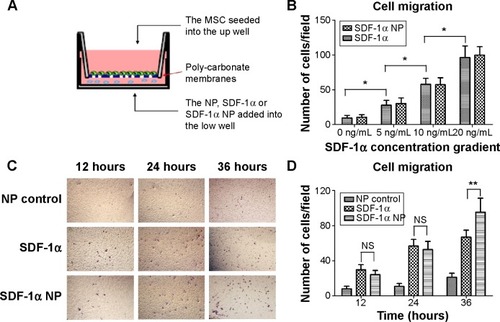
In vitro model of cell proliferation induced by VEGF-loaded CSO/H nanoparticles
First, 5×103 HUVECs were seeded into each well of a 96-well plate. The HUVECs of ECGS group were cultured with ECM (1% ECGS, 5% fetal bovine serum), the cells of VEGF groups were cultured with ECM (5% fetal bovine serum, various concentrations of VEGF solution), the cells of VEGF NP groups were cultured with ECM (5% fetal bovine serum, various concentrations of VEGF-loaded nanoparticles), the cells of NP groups were cultured with ECM (5% fetal bovine serum, nanoparticle solution). Following a predetermined period of incubation, the cell population was estimated by MTT assay, as described earlier.
In vivo study of the cytokine dispersion profiles
Dispersion of the cytokines from the CSO/H nanoparticles was quantified in vivo using fluorescence molecular tomography (FMT4000, PerkinElmer, Wellesley, MA, USA). The VEGF was dissolved in phosphate-buffered saline solution (pH 7.4), and then mixed with Cy5 fluorescence cytokine antibody and incubated for one hour at room temperature. The Cy5 fluorescence antibody and VEGF combination was then added to the CSO/H nanoparticle suspension and stirred for 5 minutes at room temperature.
Three-week-old male ICR mice were randomly divided into two groups, with one group to receive 100 μL of the Cy5 fluorescence antibody and VEGF and the other group to receive nanoparticles containing the Cy5 fluorescence antibody and VEGF. Each study treatment was injected subcutaneously into the back of each mouse after anesthesia with sevoflurane. The mice were observed immediately by fluorescence molecular tomography to detect the dispersion of Cy5 fluorescence at predetermined time points. All procedures involving animals were approved by the animal ethics committee of Central South University, People’s Republic of China.
Statistical analysis
The study results are shown as the mean ± standard deviation. Two-way analysis of variance and Student’s t-tests were performed using GraphPad Prism version 5 software (GraphPad Software, La Jolla, CA, USA). P<0.05 was taken to be statistically significant.
Results
Characterization of CSO/H nanoparticles
Characterization of the CSO/H nanoparticles is shown in . The self-assembled nanoparticles were prepared to contain four different ratios of CSO to heparin. The particle sizes in the four groups were in the range of 96.2–210.5 nm. Nanoparticle groups 1, 3, and 4 had a good polydispersity index (less than 0.25). The zeta potentials in these three groups were also favorable (absolute values greater than 20 mV). shows the cytokine encapsulation efficiency of the nanoparticles. The group 1, 2 and 3 nanoparticles had high encapsulation efficiency (over 90%). The optimal size of nanoparticles designed for drug delivery should be approximately 50–150 nm, to confer a high surface area-to-volume ratio. The polydispersity index less than 0.25 indicates that the size distribution of the nanoparticles was uniform and suitable for the requirements of this study. We selected the group 3 CSO/H nanoparticles for further study because of their negative charge (zeta potential approximately -27.3 mV), polydispersity index of 0.091, and particle size of about 140.2 nm. shows the size distribution and shows the transmission electron microscopic images for these CSO/H nanoparticles, which were spherical with a mean diameter of around 140.2 nm, suggesting an ideal size for drug delivery.
Table 2 Characteristics of CSO/H nanoparticles, including SDF-1α and VEGF encapsulation efficiency in various cytokine/nanoparticle (w/w) ratios
Effect of SDF-1α-loaded CSO/H nanoparticles on migration of MSCs
The ability of SDF-1α to induce chemotaxis in vitro was tested using a transwell system. First, MSCs were induced for 20 hours by different concentrations of SDF-1α (0, 5, 1, or 20 ng/mL) alone or loaded into CSO/H nanoparticles. Migration of MSCs across the transmembrane was then quantified by removing the cells from the seeded side and staining the underside of the membrane with crystal violet. SDF-1α induced migration of the MSCs across the transwell membrane and the effect was dependent on the SDF-1α concentration gradient (, P<0.05). There was no significant difference in number of migrated cells between the SDF-1α alone group and SDF-1α nanoparticle group. MSCs were then induced for 12–36 hours by CSO/H nanoparticles alone, 10 ng/mL SDF-1α alone, or 10 ng/mL SDF-1α loaded into CSO/H nanoparticles. There was no statistically significant difference in the numbers of MSCs crossing the trans-membrane until 36 hours of incubation (P<0.05, ), indicating that CSO/H nanoparticles could maintain the bioactivity of SDF-1α for a long period of time.
Cytotoxicity of CSO/H nanoparticles
An MTT assay was used to evaluate the cytotoxic effects of CSO/H nanoparticles on HUVECs, which were cultured in 200 μL of ECM (5% fetal bovine serum and 1% ECGS) with or without 20 μL of different concentrations of nano-particles for 5 days. As shown in , the degree of inhibition of HUVECs was dependent on the nanoparticle concentration.
Figure 4 Cell proliferation test using the MTT assay. Cytotoxicity experiment using 20 μL of different concentrations of nanoparticles added in 200 μL of endothelial cell medium (1% endothelial cell growth supplement) and incubated with human umbilical vein endothelial cells for 5 days.
Notes: Endothelial cell growth supplement contains various growth factors, hormones, and proteins necessary for culture of endothelial cells. P<0.05 between two groups, n=4.
Abbreviations: MTT, 3-(4,5-dimethylthiazol-2-yl)-2,5-diphenyltetrazolium bromide; OD, optical density.
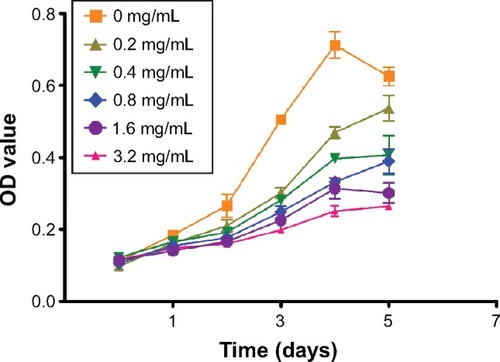
Activity of VEGF loaded by CSO/H NP
HUVECs were cultured in ECM (without ECGS) with various concentrations of VEGF or in 1% ECGS alone for 5 days. An MTT assay was then used to observe the proliferation of HUVECs according to their optical density. shows that cell proliferation increased in a VEGF concentration-dependent manner at VEGF concentrations ≤10 ng/mL (P<0.05). In contrast, the control group cultured in 1% ECGS maintained better growth because ECGS is a complete supplement for endothelial cells. However, there was no statistically significant difference in OD value between the 10 ng/mL and 50 ng/mL VEGF groups. HUVECs were then cultured with 5 ng/mL VEGF or 10 ng/mL VEGF with or without CSO/H nanoparticles for 5 days, and a comparison of the stimulating effect of VEGF alone and VEGF-loaded nanoparticles on cell proliferation is shown in . The only statistically significant difference in cell proliferation was between 5 ng/mL VEGF alone and VEGF-loaded nanoparticles on day 2 (P<0.05). These results show that the CSO/H nanoparticles maintained the bioactivity of VEGF.
Figure 5 Cell proliferation test by using an MTT assay. (A) HUVEC proliferation test with various concentrations of VEGF after incubation for 5 days. (B) HUVEC proliferation test with various concentrations of VEGF and VEGF-loaded nanoparticles after incubation for 5 days.
Note: *P<0.05 between 0, 2, 5, and 10 ng/mL VEGF groups, n=4.
Abbreviations: ECGS, endothelial cell growth supplement; NP, nanoparticles; HUVEC, human umbilical vein endothelial cells; MTT, 3-(4,5-dimethylthiazol-2-yl)-2,5-diphenyltetrazolium bromide; OD, optical density; VEGF, vascular endothelial growth factor; NS, not statistically significant.
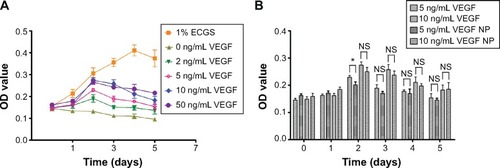
Dispersion of cytokines from CSO/H NP in vivo
The rate of dispersion of VEGF in CSO/H nanoparticles was quantified in an vivo model using fluorescence molecular tomography (). shows a representative image from fluorescence molecular tomography. The dispersion rate of VEGF loaded into CSO/H nanoparticles was significantly lower than for VEGF alone between 30 minutes and 300 minutes (, P<0.05 or P<0.01). These results indicate that CSO/H nanoparticles enable VEGF to be maintained for a longer period of time.
Figure 6 Dispersion kinetics of VEGF from nanoparticles was measured using the fluorescence molecular tomography assay. (A) Representative images of VEGF dispersion versus time. (B) VEGF dispersion (%) versus time.
Notes: *P<0.05, **P<0.01 compared with VEGF (Cy5) nanoparticles, n=4.
Abbreviations: VEGF, vascular endothelial growth factor; NP, nanoparticles; Cy5, anti-VEGF antibody; min, minutes.
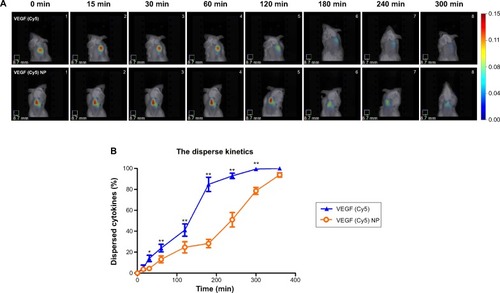
Discussion
As previously mentioned, the clinical use of stem/progenitor cell therapy has many disadvantages, including a low survival rate, relative limited cell sources, and the expense involved in obtaining sufficient cells.Citation30 Various cytokines are necessary for homing, proliferation, and differentiation of the stem/progenitor cells used in cell therapy. A delivery system targeting specific tissues is required to improve the efficiency of cytokines to promote revascularization and tissue regeneration.
Nanoparticles have been widely studied as drug delivery systems for various applications, but preparation of most nanoparticles involves organic solvents or heating, which may decrease their biodegradability and biocompatibility. For example, ferroferric oxide nanoparticles are usually prepared using an organic solvent at high temperatures.Citation31 Liposomal nanoparticles are widely used in antibiotic drug delivery systems to enhance the activity of antibiotics.Citation32 However, chloroform is often used to prepare liposomal nanoparticlesCitation33,Citation34 and is neurotoxic, so may decrease the safety of liposomal nanoparticles when used as a cytokine delivery system.
Chitosan nanoparticles are widely used in drug release systems because of the excellent properties of chitosan, such as biodegradability, biocompatibility, antimicrobial activity, and low toxicity, along with ease of preparation and versatile chemical and physiological properties.Citation35–Citation37 However, chitosan is insoluble in physiological pH solutions, and chitosan nanoparticles are prepared in an acidified environment buffered with 1% acetic acid.Citation16,Citation24 A previous study by our group demonstrated that chitosan nanoparticles were only stable in acidic solutions (pH <6.5), with the optimal pH being 5.Citation24 The low solubility of chitosan in physiological solution limits its in vivo application. Previous studies have shown that CSO, a low molecular weight chitosan (molecular weight 3,000 Da), is soluble in physiological pH solution.Citation38 The mechanism for this is not clear. The lower degree of polymerization may lead a few branching on the molecular chain of CSO and a relative more hydrophilic non-ionic groups exposed, which may make the CSO a relative loose structure and better solubility. Use of CSO could help to overcome the limitations of chitosan. CSO (used at a molecular weight 5,000 Da in our study) nanoparticles has been confirmed to be stable in physiological pH solution, so may be more amenable for clinical application. In this study, CSO/H nanoparticles were prepared by self-assembly. Like chitosan,Citation39 CSO is suitable for developing self-assembled polymeric nanoparticles due to the availability for crosslinking with free amino groups and the cationic nature which allows combination with multivalent anions. Heparin, with its multivalent anions and carboxylic group, can combine with CSO. The charge on the CSO/H nanoparticle is determined by the ratio of the surface molecules (CSO and heparin). The positive zeta potential for the group 1 and 2 nanoparticles suggests that the nanoparticle surface is covered by more CSO than heparin (). The negative charge on the group 3 and 4 nanoparticles meant a higher ratio of heparin to CSO on the nanoparticle surface (). At the same time, the stability and size of these nanoparticles were mainly influenced by the total charge on the particle. The relatively larger absolute zeta potential value was associated with a comparatively small size and polydispersity index (groups 1, 3, and 4, see ). Therefore, we chose these CSO/H ratios because when the ratio is between 4:15 and 5:4, the size and polydispersity index will be much larger, even sediment appears in the suspension.
In general, exogenous additives affect cell growth and proliferation. As shown in , the CSO/H nanoparticles inhibited proliferation of HUVECs to some extent. This inhibition may have been induced by endocytotic processes stimulated by the CSO/H nanoparticles during incubation. This suggests that the concentration of CSO/H nanopar-ticles should be taken into consideration in the following experiment. The high encapsulation efficiency and loading capacity of the CSO/H nanoparticles means that a very small amount of CSO/H nanoparticles can deliver enough cytokines to target tissues, which can reduce the inhibition effect of nanoparticles on cell proliferation. Therefore, we used CSO/H nanoparticles at a concentration of 0.2 ng/mL.
SDF-1α has been demonstrated to be important for mediating mobilization, migration, and homing of stem/progenitor cells,Citation40 and VEGF is important for cell proliferation and angiogenesis during the process of tissue regeneration.Citation41,Citation42 Therefore, we used SDF-1α and VEGF to study the bioactivity of cytokine-loaded CSO/H nanoparticles. Our results show that CSO/H nanoparticles can load not only a large amount of cytokines, but also a variety of cytokines (such as SDF-1α and VEGF, ), indicating that these nanoparticles could serve as a carrier for cytokines. We believe that other cytokines, such as placental growth factor, platelet-derived growth factor, and fibroblast growth factor, could also be loaded into CSO/H nanoparticles. Cytokines have a very short half-life, and are very vulnerable in a hostile environment.Citation43,Citation44 Maintenance of bioactivity is the most important study criterion when evaluating a cytokine delivery system. Therefore, the stability of CSO/H nanoparticles in physiological pH solution was taken into consideration. In this study, the bioactivity of SDF-1α and VEGF carried by CSO/H nanoparticles was evaluated by cell migration assay and MTT assay. Our results show that CSO/H nanoparticles maintained the bioactivity of both SDF-1α and VEGF ( and ), and that this bioactivity was concentration gradient-dependent ( and ). We also found that the CSO/H nanoparticles could maintain the bioactivity of SDF-1α for extended periods of time and recruit more MSCs (). Our in vivo dispersion test showed further that the CSO/H nanoparticles could retain VEGF for longer at the injection site (). The above findings demonstrate that CSO/H nanoparticles can enable a large amount of cytokines to localize and retain their bioactivity for a longer period of time.
We have demonstrated that self-assembled CHO/H nanoparticles are a potential cytokine delivery system for tissue regeneration, with the advantages of stability in physiologic pH solution, a high encapsulation efficiency and loading capacity, no decrease in the bioactivity of the cytokines carried, slow/controlled cytokine dispersion, and less toxicity.
However, there are some limitations to our study. An animal model may need to be developed to investigate the availability and effectiveness of CSO/H nanoparticles for targeted delivery of cytokines in vivo. The local retention time of CHO/H nanoparticles is relatively short, so further investigations are needed to refine these nanoparticles so that they can be retained for longer at their target site.
Conclusion
CSO/H nanoparticles can be used as a cytokine delivery system. They can be prepared by self-assembly using CSO and heparin. They have a high cytokine loading capacity, are stable in physiological pH solution, and can maintain the bioactivity of cytokines. Therefore, these novel CSO/H nanoparticles may be a promising cytokine delivery system for tissue regeneration.
Acknowledgments
This work was supported by a grant from the Natural Science Foundation of Hunan Province (2015JJ4064). The authors appreciate the editorial assistance of Wenwu Zhang and Jian Hu in the preparation of this paper.
Disclosure
The authors report no conflicts of interest in this work.
References
- DomianIJChiravuriMvan der MeerPGeneration of functional ventricular heart muscle from mouse ventricular progenitor cellsScience200932642642919833966
- PasalaTSattayaprasertPBhatPKAthappanGGandhiSClinical and economic studies of eptifibatide in coronary stentingTher Clin Risk Manag20141060361425120366
- MollmannHNefHMVossSStem cell-mediated natural tissue engineeringJ Cell Mol Med201115526219941631
- BlanpainCFuchsEStem cell plasticity. Plasticity of epithelial stem cells in tissue regenerationScience2014344124228124926024
- DongQYangYSongLQianHXuZAtorvastatin prevents mesenchymal stem cells from hypoxia and serum-free injury through activating AMP-activated protein kinaseInt J Cardiol201115331131620832877
- MehrpourMEsclatineABeauICodognoPOverview of macroautophagy regulation in mammalian cellsCell Res20102074876220548331
- GhadgeSKMühlstedtSÖzcelikCBaderMSDF-1α as a therapeutic stem cell homing factor in myocardial infarctionPharmacol Ther20111299710820965212
- PennMSPastoreJMillerTArasRSDF-1 in myocardial repairGene Ther20121958358722673496
- MurphyJWChoYSachpatzidisAFanCHodsdonMELolisEStructural and functional basis of CXCL12 (stromal cell-derived factor-1 alpha) binding to heparinJ Biol Chem2007282100181002717264079
- IzuagieIAPelhamCJAgrawalDKSynergistic effect of angiotensin II on vascular endothelial growth factor-A-mediated differentiation of bone marrow-derived mesenchymal stem cells into endothelial cellsStem Cell Res Ther20156425563650
- SaptarshiSRDuschlALopataALInteraction of nanoparticles with proteins: relation to bio-reactivity of the nanoparticleJ Nanobiotechnol20131126
- YameenBChoiWIVilosCSwamiAShiJFarokhzadOCInsight into nanoparticle cellular uptake and intracellular targetingJ Control Release201419048549924984011
- Quintanar-GuerreroDAllemannEFessiHDoelkerEPreparation techniques and mechanisms of formation of biodegradable nanoparticles from preformed polymersDrug Dev Ind Pharm199824111311289876569
- RagelleHRivaRVandermeulenGChitosan nanoparticles for siRNA delivery: optimizing formulation to increase stability and efficiencyJ Control Release2014176546324389132
- KumarAZhangXLiangXJGold nanoparticles: emerging paradigm for targeted drug delivery systemBiotechnol Adv201331559360623111203
- RibeiroTGChavez-FumagalliMAValadaresDGNovel targeting using nanoparticles: an approach to the development of an effective anti-leishmanial drug-delivery systemInt J Nanomedicine2014987789024627630
- YuanQShahJHeinSMisraRDControlled and extended drug release behavior of chitosan-based nanoparticle carrierActa Biomater201061140114819699817
- DasSChaudhuryANgKYPreparation and evaluation of zinc-pectin-chitosan composite particles for drug delivery to the colon: role of chitosan in modifying in vitro and in vivo drug releaseInt J Pharm2011406112021168477
- TermsarasabUChoHKimDHChitosan oligosaccharide-arachidic acid-based nanoparticles for anti-cancer drug deliveryInt J Pharm201344137338023174411
- JohnsonNRWangYControlled delivery of heparin-binding EGF-like growth factor yields fast and comprehensive wound healingJ Control Release201316612412923154193
- FermasSGonnetFSuttonASulfated oligosaccharides (heparin and fucoidan) binding and dimerization of stromal cell-derived factor-1 (SDF-1/CXCL 12) are coupled as evidenced by affinity CE-MS analysisGlycobiology2008181054106418796646
- DosSCBlancCElahouelRProliferation and migration activities of fibroblast growth factor-2 in endothelial cells are modulated by its direct interaction with heparin affin regulatory peptideBiochimie2014107Pt B35035725315978
- LeeJYooJJAtalaALeeSJThe effect of controlled release of PDGF-BB from heparin-conjugated electrospun PCL/gelatin scaffolds on cellular bioactivity and infiltrationBiomaterials2012336709672022770570
- TanQTangHHuJControlled release of chitosan/heparin nanoparticle-delivered VEGF enhances regeneration of decellularized tissue-engineered scaffoldsInt J Nanomedicine2011692994221720505
- BaumannLProkophSGabrielCFreudenbergUWernerCBeck-SickingerAGA novel, biased-like SDF-1 derivative acts synergistically with starPEG-based heparin hydrogels and improves eEPC migration in vitroJ Control Release2012162687522634073
- ChiuLLRadisicMScaffolds with covalently immobilized VEGF and angiopoietin-1 for vascularization of engineered tissuesBiomaterials20103122624119800684
- GrenhaASeijoBRemunan-LopezCMicroencapsulated chitosan nanoparticles for lung protein deliveryEur J Pharm Sci20052542743715893461
- DuYZYingXYWangLSustained release of ATP encapsulated in chitosan oligosaccharide nanoparticlesInt J Pharm201039216416920362652
- ZhuHGuoZJiangXA protocol for isolation and culture of mesenchymal stem cells from mouse compact boneNat Protoc2010555056020203670
- GarbernJCLeeRTCardiac stem cell therapy and the promise of heart regenerationCell Stem Cell20131268969823746978
- WangHLiXMaoKElectrochemical immunosensor for alpha-fetoprotein detection using ferroferric oxide and horseradish peroxidase as signal amplification labelsAnal Biochem2014465C12112625168193
- CraciunescuOMoldovanLMoiseiMTrifMLiposomal formulation of chondroitin sulfate enhances its antioxidant and anti-inflammatory potential in L929 fibroblast cell lineJ Liposome Res20132314515323590340
- MessiaenASForierKNelisHBraeckmansKCoenyeTTransport of nanoparticles and tobramycin-loaded liposomes in Burkholderia cepacia complex biofilmsPLoS One20138e7922024244452
- MugabeCAzghaniAOOmriAPreparation and characterization of dehydration-rehydration vesicles loaded with aminoglycoside and macrolide antibioticsInt J Pharm200630724425016289986
- HuangYLiuTMobilization of mesenchymal stem cells by stromal cell-derived factor-1 released from chitosan/tripolyphosphate/fucoidan nanoparticlesActa Biomater201281048105622200609
- Cota-ArriolaOCortez-RochaMOBurgos-HernandezAEzquerra-BrauerJMPlascencia-JatomeaMControlled release matrices and micro/nanoparticles of chitosan with antimicrobial potential: development of new strategies for microbial control in agricultureJ Sci Food Agric2013931525153623512598
- ChenMCMiFLLiaoZXRecent advances in chitosan-based nanoparticles for oral delivery of macromoleculesAdv Drug Deliv Rev20136586587923159541
- ChaeSYSonSLeeMJangMNahJDeoxycholic acid-conjugated chitosan oligosaccharide nanoparticles for efficient gene carrierJ Control Release200510933034416271416
- LinYHChungCKChenCTLiangHFChenSCSungHWPreparation of nanoparticles composed of chitosan/poly-gamma-glutamic acid and evaluation of their permeability through Caco-2 cellsBiomacro-molecules2005611041112
- CeradiniDJKulkarniARCallaghanMJProgenitor cell trafficking is regulated by hypoxic gradients through HIF-1 induction of SDF-1Nat Med20041085886415235597
- ZhangHJiaXHanFDual-delivery of VEGF and PDGF by double-layered electrospun membranes for blood vessel regenerationBiomaterials2013342202221223290468
- FreySPJansenHRaschkeMJMeffertRHOchmanSVEGF improves skeletal muscle regeneration after acute trauma and reconstruction of the limb in a rabbit modelClin Orthop Relat Res20124703607361422806260
- VempatiPPopelASMacGFExtracellular regulation of VEGF: isoforms, proteolysis, and vascular patterningCytokine Growth Factor Rev20142511924332926
- NagasawaTCXC chemokine ligand 12 (CXCL12) and its receptor CXCR4J Mol Med (Berl)20149243343924722947

